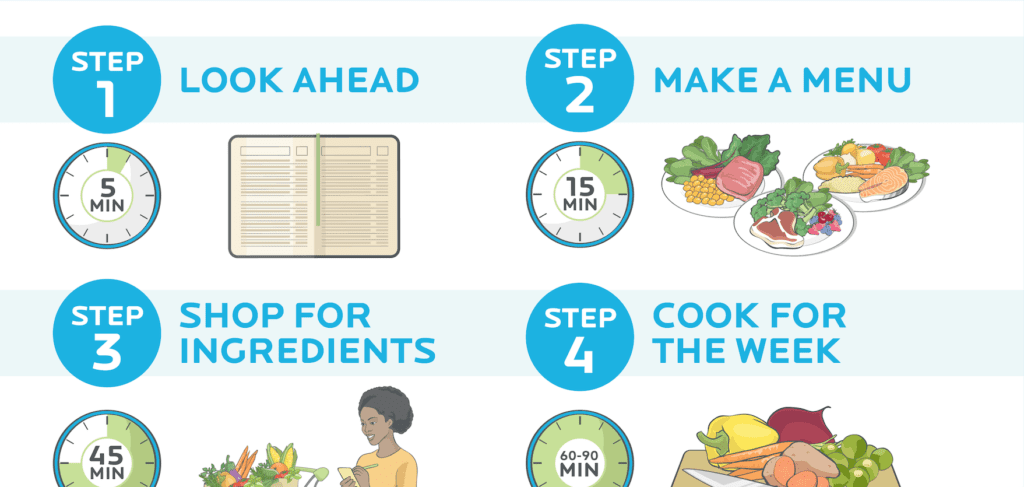How to Create a Healthy Meal Plan for Weight Loss
Unlock the secrets to crafting a foolproof, mouth-watering meal plan that effortlessly sheds pounds and boosts your health.

Image courtesy of Monstera Production via Pexels
Table of Contents
- The Power Trio: Whole Grains, Lean Proteins, and Healthy Fats
- Calculating Calorie Needs for Your Goals
- Crafting Balanced Meals with Macronutrients in Mind
- Fresh is Best: Opting for Fresh Ingredients over Packaged Options
- Meal Planning and Portion Control: Keys to Success
- Incorporating Regular Exercise for Optimal Results
- Conclusion
Maintaining a balanced and nutritious diet is essential for overall health and well-being. By incorporating whole grains, lean proteins, and healthy fats into your daily meals, you can nourish your body and achieve your weight loss goals. In this blog post, we will explore the power of this trio of nutrients, discuss calculating calorie needs, learn about macronutrients, emphasize the importance of fresh ingredients, highlight the significance of meal planning and portion control, and discover the role of exercise in achieving optimal results.
The Power Trio: Whole Grains, Lean Proteins, and Healthy Fats
The foundation of a healthy meal plan starts with whole grains, lean proteins, and healthy fats. Whole grains provide essential nutrients and fiber, promoting a feeling of fullness and sustained energy throughout the day. Incorporate options like quinoa, whole wheat bread, and brown rice into your meals. Lean proteins, such as poultry, fish, legumes, and tofu, are vital for muscle growth, repair, and satiety. These proteins are lower in fat compared to other sources, making them ideal for weight loss. Last but not least, healthy fats play a crucial role in brain function, hormone regulation, and nutrient absorption. Avocados, nuts, olive oil, and fatty fish like salmon are excellent sources of healthy fats.
Get Your Free Meal Planner and Start Losing Weight Today!
Sign up for our newsletter to receive expert tips and delicious recipes.
Calculating Calorie Needs for Your Goals
To create an effective meal plan for weight loss, it is essential to calculate your calorie needs accurately. Factors such as age, gender, weight, physical activity level, and specific goals like weight loss or muscle gain influence your daily calorie intake. By creating a calorie deficit, you can successfully achieve weight loss, while a surplus helps with muscle gain. Utilize online resources or formulas to calculate your calorie needs, and consult with a registered dietitian for personalized advice.
Check out this life-changing blog post on how to create a healthy meal plan for weight loss! Implementing these tips can lead you to a healthier, happier you! [Click Here] #wellness #healthyeating #weightlossgoalsTweet Quote
Crafting Balanced Meals with Macronutrients in Mind
Macronutrients, including carbohydrates, proteins, and fats, are the building blocks of a balanced diet. It is crucial to incorporate the right amounts of each macronutrient into your meals. For example, a balanced meal can comprise a quinoa salad with grilled chicken, various vegetables, and a drizzle of olive oil. Experiment with different recipes that combine whole grains, lean proteins, and healthy fats to create nutritious and satisfying meals that support your weight loss goals.

Image courtesy of www.precisionnutrition.com via Google Images
Fresh is Best: Opting for Fresh Ingredients over Packaged Options
When it comes to creating a healthy meal plan, fresh ingredients always trump pre-packaged foods. Fresh fruits, vegetables, and whole grains should be the main foundation of your meals and snacks. Fresh ingredients have higher nutrient content, lower added sugars, and fewer additives or preservatives compared to packaged options. Incorporate more fresh produce into your diet by meal planning, shopping at local farmers markets, and involving yourself in community-supported agriculture programs.
Meal Planning and Portion Control: Keys to Success
Meal planning is a valuable tool in curating an effective and healthy meal plan. By planning your meals in advance, you reduce the chances of impulsive and unhealthy food choices. Batch cooking, prepping ingredients, and using meal planning apps can streamline the process and make it more enjoyable. Additionally, portion control plays a significant role in managing your daily calorie intake. Utilize measuring tools to ensure that you are consuming appropriate portion sizes and keeping your meals in line with your weight loss goals.

Image courtesy of www.sleekgeek.co.za via Google Images
Incorporating Regular Exercise for Optimal Results
While a healthy meal plan is essential for weight loss, incorporating regular exercise into your routine is equally important. Strength training, cardiovascular activities, and flexibility exercises all contribute to optimal results. Find physical activities you enjoy and make them a part of your lifestyle. Exercise not only helps burn calories but also improves overall well-being and increases metabolism. Aim for at least 150 minutes of moderate-intensity activity or 75 minutes of vigorous activity each week, spread across several days.
Get Your Free Meal Planner and Start Losing Weight Today!
Sign up for our newsletter to receive expert tips and delicious recipes.
Conclusion
Creating a healthy meal plan for weight loss is achievable by prioritizing the trio of whole grains, lean proteins, and healthy fats. Calculating your calorie needs, understanding macronutrients, opting for fresh ingredients, practicing meal planning and portion control, and incorporating regular exercise are key components of a successful weight loss journey. By curating your meals and adopting a mindful approach to nutrition, you can nourish your body, achieve your weight loss goals, and improve your overall well-being.



0 Comments